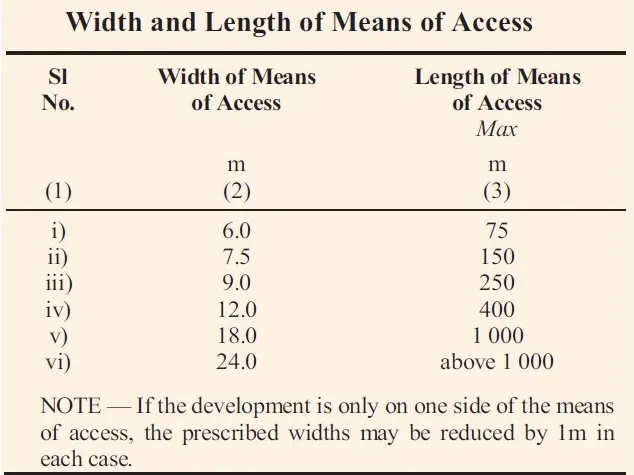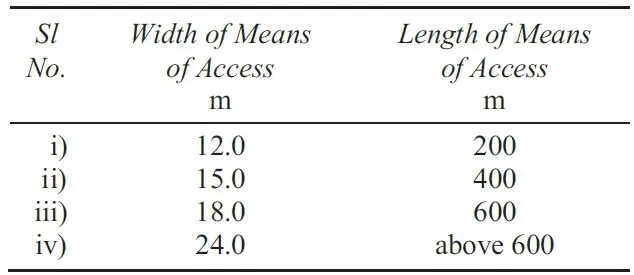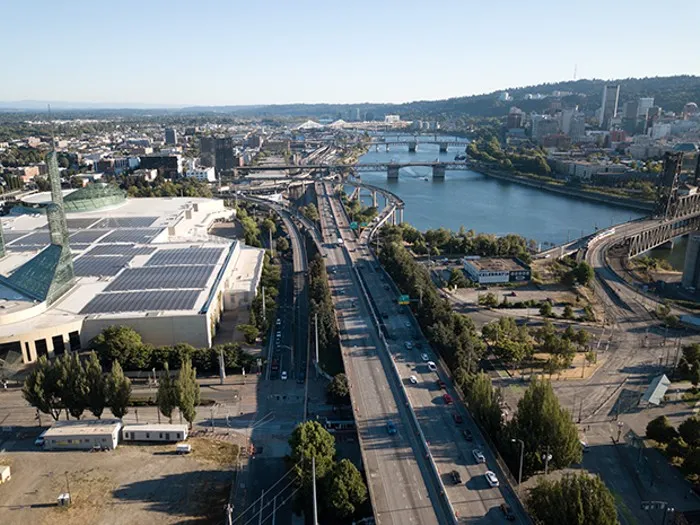If you want to know about the fire tower or stairwell pressurization system or firefighting in multistory developments, please click the link.
Means of access refers to the methods or ways in which people can enter or reach a particular location or resource. The means of access can vary depending on the context and the location in question.
- Every building/plot shall abut on a public/private means of access like streets/roads duly formed.
1) Width of Means of Access
- The residential plots shall abut on a public means of access like street/road. Plots which do not abut on a street/road shall abut/front on a means of access, the width and other requirements of which shall be as given in Table given below.

i) Other Buildings
- For all assembly buildings like, theatres, cinema houses, assembly halls, stadia; educational buildings; markets, hospitals; industrial buildings and other buildings which attract large crowd, the means of access shall not be less than the following:

- Further, in no case shall the means of access be lesser in width than the internal accessways in layouts and subdivision.
2) Footpaths and Pathways
i) Footpaths

- Footpath should be normally designed for a pedestrian Level of Service (LOS) B, thereby providing wide pedestrian facilities for safe, pleasant and comfortable walking. Under resource constraint, LOS C may be adopted for deciding the width of footpath mentioned in Table given below.

- The width of footpaths depends upon the expected pedestrian traffic and may be fixed with the help of the following norms subject to not being less than 1.8 m.
- The land use adjacent to roads significantly influences generation of pedestrian traffic. Recommended width of footpath along various land uses are given in Table below.

- The footpath shall be level, non-slip and continuous, and shall be provided with tactile orientation, kerb and kerb ramp.
ii) Pathways

- The approach to the buildings from road/street/internal means of access shall be through paved pathway complying with requirements as given above.
The length of the pathway shall not be more than 30 m.
The safety concern of cyclists and pedestrians should be addressed by encouraging the construction of segregated rights of way for bicycles and pedestrians.
- In the case of special housing schemes for low income group and economically weaker section of society developed up to two storeyed row/cluster housing scheme, the main means of access through pedestrian pathway width shall be 3 m subject to provisions of………..
The maximum height of building shall not exceed 1.5 times the width of road abutting plus the front open space, subject to the requirement of front open space of a maximum of 16 m;
- The pedestrian pathway shall not serve more than 8 plots on each side of the pathway; the length of the pathway shall be not more than 60 m.
- The length of the main means of access shall be determined by the distance from the farthest plot (building) to the public street. The length of the subsidiary accessway shall be measured from the point of its origin to the next wider road on which it meets.
- In existing built-up areas in the case of plots facing street/means of access less than 4.5 m in width, the plot boundary shall be shifted to be away by 2.25 m from the central line of the street/means of accessway to give rise to a new street/means of accessway of 4.5 m width.
- The means of access shall be levelled, metalled, flagged, paved, sewered, drained, channelled, lighted, laid with water supply line and provided with trees for shade to the satisfaction of the Authority free of encroachment by any structure or fixture so as not to reduce its width below the minimum required under Width of Means of Access
and shall be maintained in a condition to the satisfaction of the Authority. - If any private street or any other means of access to a building is not levelled, metalled, flagged or paved, sewered, drained, channelled, lighted or laid with water supply line or provided with trees for shade to the satisfaction of the Authority, who may, with the sanction of the Authority, by written notice require the owner or owners of the several premises fronting or adjoining the said street or other means of access or abutting thereon or to which access is obtained through such street or other means of access or which shall benefit by works executed, to carry out any or more of the aforesaid requirements in such manner as he shall direct.
- If any structure or fixture is set upon a means of access so as to reduce its width below the minimum required, the Authority may remove the same further and recover the expenses so incurred from the owner.
3) Access from Highways/Important Roads

- No premises other than highway amenities like petrol pumps, motels, etc., shall have an access direct from highways and such other roads not less than 52 m in width, which the Authority with the approval of the highway authority shall specify from time to time.
- For all other buildings, the access to the plot from the highway shall be only through a service road/lane as per the stipulation of the highway authority.
- The Authority shall maintain a register of such roads which shall be open to public inspection at all times during office hours.
- The portion of such roads on which direct access may be permitted shall be as identified in the Development Plan. However, in the case of existing development on highways/other roads referred to above, the operation of this clause shall be exempted.
- These provisions shall, however, be subject to the provisions of the relevant State Highway Act, and The National Highway Act, 1956.
- For high rise buildings and special buildings (As per “Fire and Life Safety” of the Code), the following additional provisions of means of access shall be ensured:
- The width of the main street on which the building abuts shall not be less than 12 m and one end of this street shall join another street not less than 12 m in width.
- The road shall not terminate in a dead end; except in the case of residential building, up to a height of 30 m.
- The approach to the building and open spaces on all its sides shall be not less than 6 m in width, and a turning radius of minimum 9 m shall be provided for fire tender movement of fire tenders weighing up to 45 t. The same shall be hard surface capable of taking the mass of fire tender, weighing up to 45 t minimum. For heavier fire tenders, the minimum width, turning radius and the hard surface capable of taking the fire tender loads shall be as per the requirement laid down by the Fire Department. The layout for the open space for fire tender movement shall be done in consultation with the Chief Fire Officer of the city, which shall be kept free of obstructions and shall be motorable. The compulsory open spaces around the building shall not be used for parking.
- The main entrance to the plot shall be of adequate width to allow easy access to the fire engine and in no case shall it measure less than 6 m. The entrance gate shall fold back against the compound wall of the premises, thus leaving the exterior accessway within the plot free for movement of fire tender. If the main entrance at the boundary wall is built over, the minimum clearance shall be 4.5 m.
Means of access can be important considerations in planning for transportation, infrastructure, and public policy.